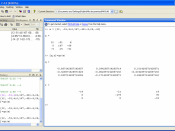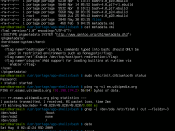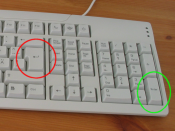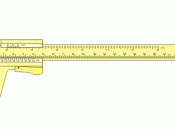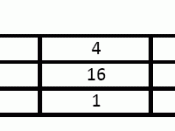PORT The Port Twiddling Tool By John De Armond (jgd@dixie.com) Rapid Deployment Systems, Inc.
Introduction PORT is a tool written to facilitate working with I/O ports on the PC or Intel processor-based hardware. It has many uses. Among them: * Debugging new hardware.
* Reverse engineering old hardware.
* Finding out where an adaptor card decodes its ports.
* Otherwise manipulating I/O ports.
Among the capabilities: * Read or write to a specified port.
* Read or write and then wait for a specified byte or word pattern * Read or write in byte or word modes.
* Enter or display data in either decimal or hex.
* Repeatedly read or write a port - generate nice scoping patterns.
* Repeatedly read or write and alternate between a specified bit pattern and all zeros - generates even nicer scope patterns.
* Increment or decrement port addresses while reading or writing a specified bit pattern.
* Submit commands from files.
Starting PORT Starting PORT is easy - just type "port" on the command line. There are 2 optional arguments that you may specify if desired. The first argument is interpreted as the port and the second is interpreted as the bit pattern. These must be specified in hex with no leading modifiers, eg, port 3b4 0111 DON'T use 0x3b4 or any other c-like notation You can redirect a configuration file into PORT: port
The Command Line When you invoke PORT, you will see something like this: PORT v1.0 03/04/91 by John De Armond. (jgd@dixie.com) Usage: port Arguments are in hex Commands: r read the port w write the port e Enter a byte (word in designated mode, hex or decimal) m Mode (x=hex, d=dec, b=byte, w=word) t n Toggle bit c Clear all bits s Set all bits p Set port address g Go In or Go Out - perform action continuously i Increment port address one count d Decrement port address one count q Quit < Redirect commands from a file ? Help While in "go out" mode, keys 0-f will toggle bits, will cause the output to alternate between the byte pattern and all zeros.
Command (help-?): As you enter commands, you will see a display as follows: Bits 5432 1098 7654 3210 Port: 0000 Byte: 0100, 0000 0001 0000 0000 Mode= HEX Data= BYTE This display shows you the currently addressed port, the current bit pattern, the mode and the data size. The "mode" refers to the display mode and can be either decimal or hex. The mode is changed with the "mode" command or by the use of the modifiers "x" or "d" with the (E)nter command. See below.
Commands: r - read the port This command executes a read on the specified port. If the data width is set to WORD, then the LSB is written to the specified port and the MSB is written to port+1. If the data width is set to BYTE, the LSB is written to the specified port and the MSB is ignored.
If the command is followed by a hex number, the command outputs the byte specified with the "enter" command and then reads on the port looking for the byte pattern specified in the command. This is useful when testing latching ports or when testing devices that return a result code on the same port.
w - write the port Same as the above except that a write is executed.
e - Enter a byte or word This command allows you to enter a word or byte to be written to a port.
If the command is entered with no modifier, the default entry mode is used. A specific mode can be specified with the options "x" for HEX mode or "d" for DECimal mode. Examples: e 0100 (assumes the default mode is HEX) ex 0100 ed 256 If a mode "override" is specified as above, the override sticks; ie, it becomes the new default mode.
m - Set the mode.
This command allows you to specify new modes with no other effects.
This command is somewhat overloaded in that it applies to the word size in addition to the HEX or DECimal modes. This overloading seems logical to this humble programmer and can be learned by those for which it is not.
t n - Toggle bit This command allows you to toggle the setting of any bit in a word.
"n" is the bit position starting at zero. Thus, the MSB is 15 and the LSB is 0. Example: t 3 sets the 4th bit (3rd bit numbering from 0) in the word.
c - Clear all bits This one does what it says. It clears all bits in the I/O word.
A shortcut for "ex 0".
s - Set all bits Same as above except that it sets all bits. A shortcut for "ex ffff".
p - Set port address This command enters the port address to be manipulated. It does not have a hex or decimal override because it is not anticipated that this command is a high usage one and and because people think of ports in hex and because your humble programmer got lazy :-) The entry mode is automatically the default mode. Example: e 3e4 g - Go In or Go Out This command makes PORT continuously input or output the specified word to the specified port until the key is pressed. There are several options while the "go" mode that are explained below.
i - Increment port address one count Just what it says, increase the port number by one.
d - Decrement port address one count Again, just what it says.
< - Redirect commands from a file This command directs PORT to read the specified file and interpret the file's contents as typed commands. These files are useful for storing repeated data such as port addresses and for test patterns. One can output to a port and then read another, for example. When interpreting commands from a file, PORT goes into an abbreviated message mode so that the screen is not cluttered and so that it will run faster.
q - Quit Yep, exit the program. No twiddling is done; the program simply exits.
If you want to restore a value to a port before exiting, be sure to explicitly do it.
? - Help Displays the help screen.
The GO mode: The GO mode is primarily designed to generate repetitive patterns on the I/O lines so you can observe them with an oscilloscope. When you enter the GO mode with a "gi" or "go" command, the specified byte is repeatedly output or input to the specified port as fast as the computer can do it. About 200 microseconds per cycle on a 16 mhz 386 and a standard printer port.
There are several options available while in the GO mode. They are: < Decrement the port address one count.
> Increment the port address one count.
digits 0-f Toggle the state of the specified bit.
t Enter "toggle" mode. Only valid for OUT mode. In this mode, on alternate cycles, the specified byte is output and on the other cycle, the value 0 is output. This mode generates rapid scope patterns on the data lines.
Leave GO mode.
Note that there is a loop counter displayed on the screen. For speed considerations, this display is not updated unless there is a display event. If you want to monitor the progress of the looping, simply press the space bar which makes the screen update but with no other effect.
Rights This program is copyright 1991 by John De Armond. Minimal rights reserved.
You may not sell this program and if you redistribute it, you must redistribute the self-extracting ZIP file which includes the source. Source must always be available. Other than this, you may do with this program what you like including modifying it and/or incorporating portions of the code in other programs.
If you modify the program and redistribute it, please change the name so as to avoid confusion with the real thing.
I would appreciate your sending any modifications back to me for inclusion in future releases. Before you fire off with major mods, please read the "future directions" section below and touch base with me at the email address specified below. As I use this program daily, it is likely that I've already implemented some form of your changes or at least given them some thought. Let's swap ideas and avoid the duplicate work.
Future Directions: Here are some ideas I'm going to implement in the next releases: * Trapping interrupts - PORT will trap and display any hardware interrupts it detects on specified lines.
* Programming constructs for the command language. To allow one to program a test sequence with basic decision constructs.
* A data register stack. Allows one to store away port or byte data for later use.
* Command stack with recall. Probably something similar to the Korn shell.
* Full screen mode. Probably implemented on top of PC Curses to keep the program fully freely distributable.
Building PORT: PORT was written under Boreland C++ 2.0. It uses no C++ constructs and so should be portable to Turbo C or other DOS C compilers.
It uses the project feature of Boreland C in lieu of a makefile.
There are no special compile or link options so a makefile is not really needed.
The binary in the distribution is compressed with Phil Katz's pklite program. Highly recommended.
Addresses: The easiest way to get in touch with me is via Email on the Usenet. My address is as follows: Domain: jgd@dixie.com Bang: emory!rsiatl!jgd or emory!dixie.com!jgd or (costs $$$) uunet!rsiatl!jgd Slow boat: John De Armond C/O Rapid Deployment Systems, Inc.
PO Box 670386, Marietta, Ga 30066 Shout: (404) 578 9547 If you are on Compu$erv, find out how to mail through the Compu$erve <-> Internet gateway.
I will NOT provide support via phone, though you may call to chat about new features or to discover ways to spend money with us. You may also call or write to find out about our products such as the Printer Nidget (TM), a device that lets you hang ordinary printers from Ethernets.
About Rapid Deployment Systems, Inc.
RDS is a company that specializes in fast solutions to tough problems involving embedded processors, TCP/IP networking and custom systems. We have the facilities to rapidly take an idea from concept to implementation in hardware and/or software. We specialize in Intel and Zilog processors.
In addition to custom services, we have the following products under development that will be ready for introduction in early summer 1991: The Printer Nidget (tm) The Printer Nidget is the first in a series of Network Widgets. It is a small modem-like box that speaks TCP/IP and allows you to attach ordinary printers to an Ethernet network and address them from multiple hosts. It is designed to sit under LP (SysV) or LPR (Berkely) and speaks FTP and RSH. Up to 2 printers, either parallel or serial, may be attached to the Printer Nidget. Pseudo-commands passed to rsh on the host specify the port to direct the print job and other operating parameters. Price is expected to be under $500.
The Midget (tm) The Midget (Modem Widget) is a multi-purpose modem controller that sits between hosts and modems and does the following: * Controls power to the modem based on DTR.
* Initializes the modem on each powerup.
* Drops idle lines after programmed intervals.
* Breaks up getty-modem chats.
* Provides absolute dial-out security.
This very inexpensive device is designed to address the chronic problems faced by administrators when integrating so-called "smart" modems with Unix and BBS systems. It will also be of interest to those who have dial-out only systems that need absolute security against hacking when the modem is unused. It will be available in 2, 4 and 8 port versions. Estimated price - $75 per port.
- END -
